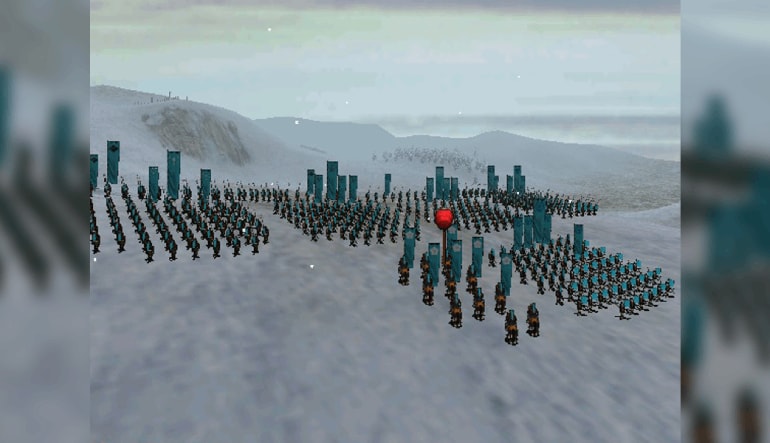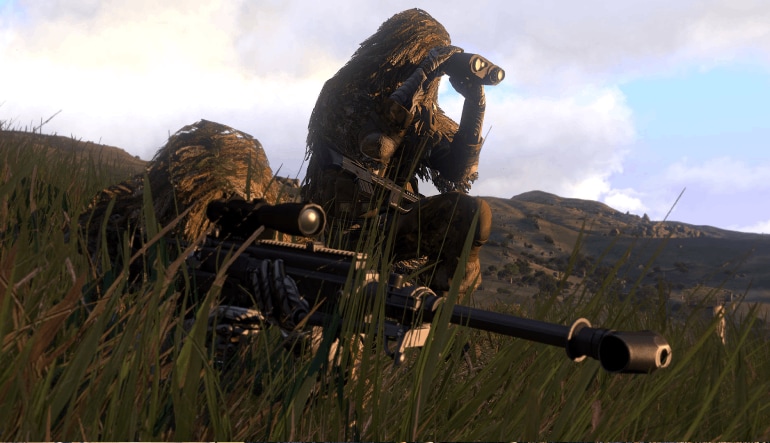Planning battles throughout the centuries required military thinkers to test their visions in a game-like manner (e.g., by placing objects symbolizing units and war machines on a map), remarkably resembling… paper war games!
True wargaming was officially invented in Prussia in the early 19th century. Interestingly, the Prussian military successfully used it to train their soldiers. Soon after, other countries began adapting the Prussian idea and used wargames for training purposes. Of course, civilians also played such games, but they weren’t very popular due to their difficulty.
This changed in the 1980s and 1990s when the idea of wargaming transitioned from paper to computers — certain mechanics were simplified, and visual representation allowed for greater immersion.
Are you curious about the evolution of video games focusing on strategic-tactical war scenario gameplay? We invite you to a brief guide — learn the history of war video games!
| Game | Release | Genre | Developer | |
|---|---|---|---|---|
 | Sniper Elite 5 | 2022-05-26 | Action | Rebellion |
 | Call Of Duty WW II | 2017-11-03 | Action & Shooter | Raven Software |
 | Arma 3 Digital Deluxe Edition | 2013-09-12 | Strategy | Bohemia Interactive |
 | Squad | 2015-12-14 | Action & Shooter | Offworld Industries |
 | Ready Or Not | 2021-12-18 | First-Person | VOID Interactive |
 | Hell Let Loose | 2019-06-06 | Indie | Team17 |
 | Call To Arms Gates Of Hell Ostfront | 2020-12-27 | Shooter | Barbedwire Studios |
 | Six Days In Fallujah | 2023-06-22 | Shooter | Konami |
 | Rising Storm 2 Vietnam | 2017-05-30 | Action & Shooter | Antimatter Games |
 | Full Spectrum Warrior | 2004-09-21 | Strategy | Pandemic Studios |
The Early Days
The beginning of the video game era occurred in the late 1940s and 1950s, but the games of that time were usually academic projects created on machines entirely inaccessible to the general public.
The breakthrough came in the 1970s, when microprocessors replaced TTL technology, allowing for greater popularization of computer hardware.
Early computers and consoles had significant technological limitations and couldn’t process the amount of data that modern games have. As a result, the first more complex games were text-based.
Among the earliest computer strategy text games was Star Trek (1972), which wasn’t a typical wargame but required players to strategically plan space wars.
The first graphical, typical 4X war game was Empire from 1972, made by Peter Langston. Unfortunately, it was a university project and the original game code was lost when the university upgraded to new equipment. However, the game was recreated in 1984.
Computer Bismarck, released in 1980 by Strategic Simulations on the Apple II, focusing on the final battle of the titular ship is then considered as the first publicly available computer wargame. Created by Atari a year later, Eastern Front (1941) was, in turn, called “the first war game that competed with pencil-and-paper games.”
Certainly, the pioneers of the real-time strategy genre should also be mentioned, such as Utopia (1982) and Legionnaire (1982), as well as Combat Leader and Stonkers from 1983. These were military and historical games focusing on simulating various wars.
Advancements in the 1990s
The next decade brought significant advancements with the development of the real-time strategy and tactical simulation genres, striving to accurately reflect historical realities.
In 1992, Gary Grigsby’s Pacific War, released by the already mentioned Strategic Simulations, was introduced to gamers. Two years later, the same team released another title: Panzer General. Both games were set during World War II.
Other notable games prioritizing realism were Steel Panthers (1995) and Close Combat (1996). Both titles also focused on World War II and meticulously recreated the nations and equipment involved in the conflict.
The true beginning of the modern wargaming era is considered the release of Command & Conquer (1995). The game, although it was not the first war RTS, and not a historical representation of real battles, became a model for many subsequent titles in the genre and spawned numerous sequels. Similarly, Warcraft: Orcs & Humans (1996), even though it was set in a fantasy world, also laid the foundation for the genre, inspiring many future titles because of its complex, yet easy-to-understand mechanics.
The 2000s: A New Era of Realism and Online Play
The late 1990s and early 2000s marked another revolution in war games. Previously single-player, gameplay moved online!
Players could now “declare wars” not only against computer-controlled opponents but also against each other. The ability to conduct virtual battles with real, thinking, unpredictable opponents significantly enhanced gameplay realism!
Notable titles from this period include the Total War series, starting with Shogun: Total War (2000), and Combat Mission: Beyond Overlord (2000), which featured well-developed multiplayer modes.
The introduction of MMO modes also contributed to the genre’s growing popularity. The ability to compete against many players simultaneously, especially participating in battles from a first-person perspective — as a soldier on the front lines, a tank operator, or a military aircraft pilot — showed players a whole new side of war games.
This type of gameplay also attracted players more interested in action than the tactical-strategic aspect of war games. Titles worth mentioning here include War Thunder (2012), World of Tanks (2010), and World of Warships (2015).
The significant improvement in the quality of contemporary games’ graphics also enhanced immersion and attracted more players to the genre. During this period, popular games like the Call of Duty and Battlefield series, as well as other similar first and third-person war shooters, gained popularity.
The 2010s to Present: Diversification and Innovation
Beyond traditional strategy and tactical games and war shooters, other game genres began to join the broader category of war games over time. War/military themes also inspired individual developers, who love experimenting with different genres and types of gameplay.
This led to the creation of various indie and hybrid games addressing war topics (real, historical, or set in an alternate reality or future) while introducing new, interesting mechanics.
An example is This War of Mine (2014), an independent game with adventure elements that tells the story of civilians surviving in an occupied city.
A significant step towards the future of this vast subgenre was the introduction and popularization of VR technology. It allowed for even more profound experiences and immersion in the scenarios played out — for example, in the aforementioned FPS shooters.
Regarding the future of war games… well, considering the rapid development of AI technology affecting almost all industries, including gaming, we can expect increasingly complex and “realistic” games where AI-controlled opponents will be much more unpredictable. This will undoubtedly lead to another major revolution in the war-themed gaming market.
Cultural Impact and Ethical Considerations
That war games have their enthusiasts is no secret! However, it is worth knowing that beyond entertainment value, they also carry significant educational value.
Although the topics of wars are often mentioned in school history lessons, they usually focus on memorizing the dates of major events… After learning them for an exam, they are usually quickly forgotten.
Playing games set during great wars allows players to “personally” step into their center, experience the events in their own way, and thus understand and remember them much better.
Depending on the chosen genre, they can also teach other useful skills: dexterity, logical thinking, planning tactics and strategies, management, etc.
Experiencing the hardships of war from a direct perspective also carries emotional and ethical value. It helps understand how challenging and devastating war is, what difficulties people involved in it face, and what can lead to serious conflict.
Conclusion
As you can see, war video games have undergone significant evolution over the years.
From tactical tabletop games used for soldier education, through niche text-based games, demanding strategies, and action-filled shooters, to emotionally charged and valuable hybrid games.
It is also undeniable that this genre carries many educational and ethical values, helping better understand the history that concerns us all.
If you haven’t had the chance to play any war-themed game yet, give one of the titles we mentioned a try. Even if it turns out to not be your genre or type of game, it will undoubtedly be an interesting experience!










